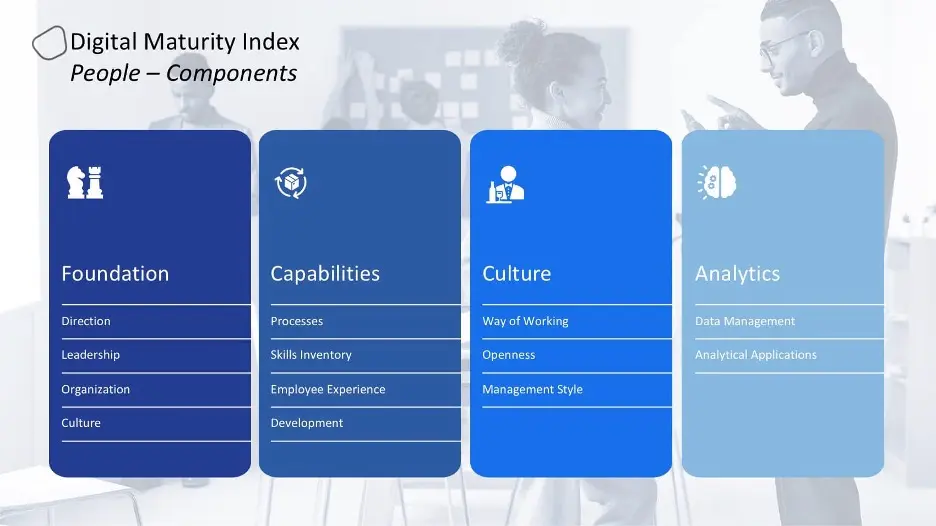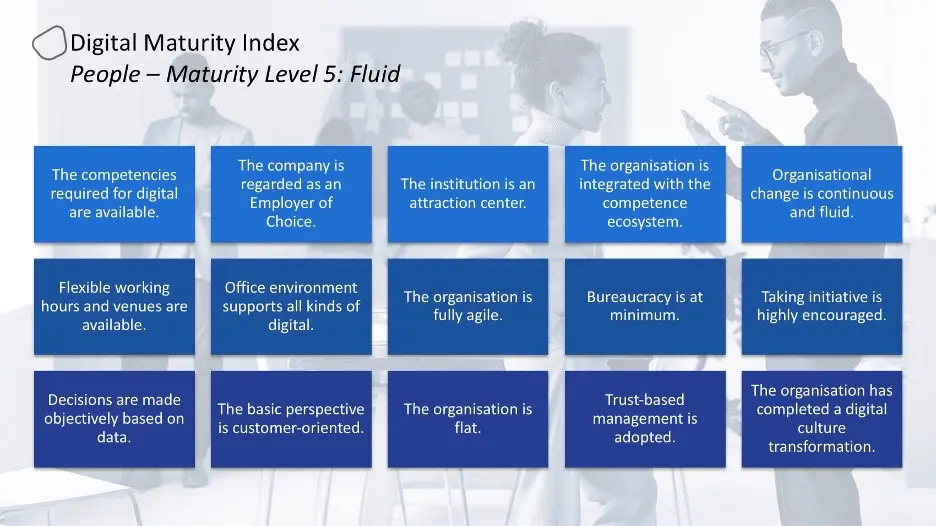
We hope you are familiar with how we gauge digital maturity at Digitopia. We have 6 “excellence dimensions” that we test to move our clients toward digital success: “Customer Excellence”, “Operational Excellence”, “People Excellence”, “Technological Excellence”, “Innovative Excellence”, and “Governmental Excellence”. We could summarize the entire “People Excellence” dimension of digital maturity in a single sentence, “Culture eats strategy for breakfast.” Thanks to Peter Drucker, this phrase has become very popular around the world. Many executives know it by heart, but very few of them actually live by it.
Cultural transformation is easier said than done. It is extremely hard to change or shift a corporate culture. Across industries, HR leaders and entire units struggle to implement this agenda successfully. However, it is a hard truth that the “People Excellence” dimension and cultural change as a whole are among the most critical and most difficult components in all change efforts within a successful digital transformation.
Seemingly overnight, the COVID-19 pandemic has taught us all that true digital transformation requires a whole new mind set, a large variety of new capabilities, and new ways of working. The organisation as a whole, specifically through the leadership of the human resources function, needs an upgrade to cope with the complexity of today and tomorrow.

To achieve success within the “People Excellence” dimension, an organization must succeed in all DMI components. We have structured these components into four main groups: The Foundation, The Capability, The Culture, and The Analytics. All of them are equally important. All of them are tightly integrated, and all of them must improve and mature simultaneously.
The Foundation group is about implementing strategic capabilities, the actualization of the “People Excellence” dimension, the appropriate placement of leadership, and establishing an optimized, lean, organized, and agile culture within the organisation.
The Capability group is about the processes within the human resources function, the skills and competency of the organization, how they are managed and developed, and how all of these components work together in the employee experience.
The Culture group is, as the word suggests, all about the corporate culture within the organisation. This includes implementing new ways of working, creating enterprise agility, moving away from silos and hierarchy, reducing bureaucracy, and opening up the organisation to the outside world.
The Analytics group is here to help employees and customers alike, augment their intelligence, crunch the numbers, and come up with suggestions for improvement. Cultural management requires very sensitive decision making in terms of attracting, hiring, retaining, developing, motivating and in some cases terminating employees, or guiding them into retirement. Analytics aids the culture in making the right decisions at the right time, with the right options.

Our Digital Maturity Index measures on a scale from 1.0 to 5.0. The first maturity level measures very basic operations, so we have labelled it “institutional”. Going up to the highest level, which we have labelled “fluid”, describes a state-of-the-art cultural excellence that is truly agile, allows employees to work from anywhere with all the required capabilities in place internally or from the ecosystem, and a “feel good” workplace.
The studies we have done in the recent past shows the “People Excellence” dimension falls among the average in many companies. The overall average of digital maturity for these companies was measured at 2.7 and the “People Excellence” dimension also averaged at 2.7. There is a lot of room for improvement. “People are our most valuable assets.” This should not be just a slogan, but an imperative.
During our work with clients we have also found out that improving the digital maturity within the “People Excellence” dimension is particularly difficult. Success within this dimension requires very strong leadership and honest support from all business units. Most business executives would agree on the irreplaceable importance of a human resources unit, however the decisions, budget and priorities affecting HR units typically tell a different story.
Brief descriptions of each level can be found in the graphic below:

During one particular study, we met a large international multi-industry conglomerate. Their digital transformation journey began long before they had met us. Several companies within the conglomerate invested heavily in processes, technology, analytics and innovation, but when we met them, we noticed that they were mostly excited about something else. They were focusing on running a collective cultural change program. They had realized the importance and the value of “enterprise agility” and decided to implement it in all their businesses; large or small, national or international; across the entire organisation.
This is a pleasant, but rare example. Agile approach is becoming very popular, especially in start-ups and companies attempting to mimic them. However, the success ratio of an agile approach outside of technological organisations is rather limited. In our conglomerate example, the executive management was truly committed and demanded this transformation from the top down. And it worked. Some of the associated companies successfully adopted agile capabilities and deployed it beyond the technology unit, incorporating the entire organisation. The HR function became an integral supporter of this transformation and provided the required training across all levels.
Today, as a result of this effort, the whole group has become a magnet for talent, start-ups, academics, and executives from all around the world. Their usual projects and their defined digital transformation programmes are successful, engaging, and delivering tangible business value. The rhythm of the conglomerate has changed for the better. A true success story that we are proud to tell.

Based on all our experiences and the best practices we have examined with DMI, we have described what the most advanced level of cultural transformation looks like.This conglomerate demonstrates what is possible when an organisation achieves the most fluid digital maturity level possible within the “People Excellence” dimension.
Imagine a company that is a magnet for the best and brightest people. A place where one can realize her dreams, an environment which is joyful and productive. Bureaucracy is mostly eradicated, the organisation enjoys flat, open communication with an open mindset, welcoming new talent and new ideas all the time. Sound great? Would you like to work here? Would you like your workplace to turn into this as well? It’s possible, and you can make it happen with digital transformation.
The most important (and most undervalued) dimension of the digital transformation process is the human aspect. Changing the culture of working, the habits, and the mindset of an organisation while making people feel good about themselves is priceless. It is the most crucial success factor for any change programme.
Let’s measure your digital maturity, to better understand where you are and where you need to go.
Check out the rest of the articles in our Digital Maturity Explained series and learn more about all the dimensions of Digitopia’s Digital Maturity Index.
Digital Maturity Explained: All About Business Performance
Digital Maturity Explained: Governance, Reimagined
Digital Maturity Explained: Operations, Rebooted
Digital Maturity Explained: Technology, Reset
Digital Maturity Explained: Innovation, Reignited

